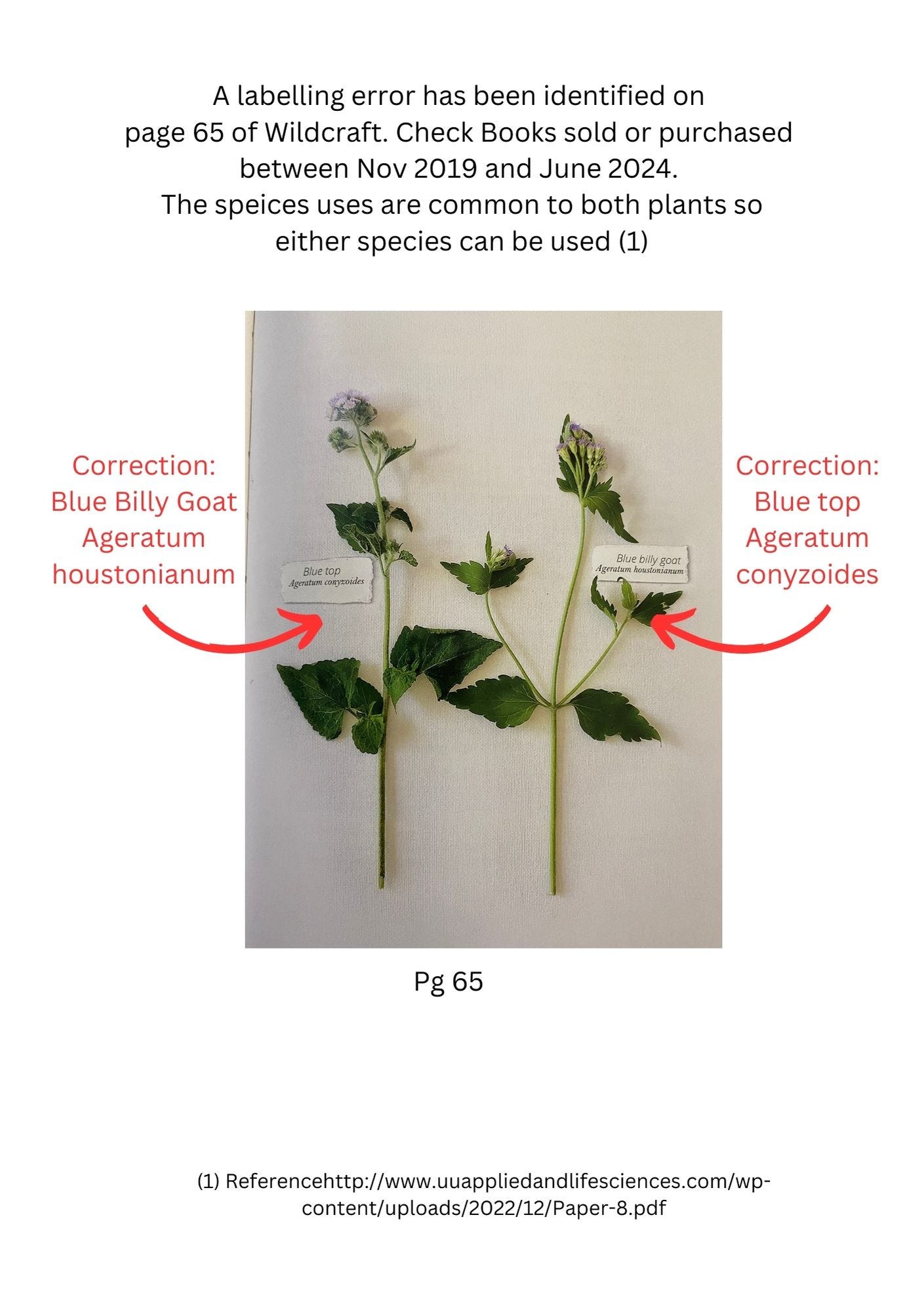As I was finishing the final edits on my new book I went to check something about Blue Top and I discovered a labelling and identification mistake for Blue Top and Blue Billy Goat Weed on Page 65 of Wildcraft. I know how important correct ID is for you and I feel the same way so this mistake cut me to the core.
My immediate reaction on realising this was a dry retching, hurrrghh, hurrggggghhh, HURRRGGG!! nausea, panic and anxiety.
This was followed by manic research into the implications of such a mistake. But as is common to many plants with multiple similar species, their uses tend to largely overlap. Just as with the multiple species of nettles or wild raspberries or oxalis, while variations exist between species, and some species will be preferable in certain situations, generally multiple species are often used for similar purposes.
If you would like to read in more detail about the uses of both Ageratum species and how their uses overlap I recommend this article from the Uttaranchal Journal of Applied and Life Sciences. Click here to read the full article
Even in this article they say “Ageratum houstonianum Mill plant is ubiquitously found in every continent of the world. It is commonly known as Blue mink. Whereas Ageratum conyzoides Mill. is commonly known as blue billygoatweed.”
Whereas other reputable sources like the Atlas of Living Australia refer to Ageratum houstonianum as Blue Billy Goat weed not A. conyzoides. (Seems there is no end to the confusion) Click here for the link
But at the end of the day both species can be used and I suggest you grab your copy of Wildcraft and change the labels on pg 65.
I’m really sorry for adding to the confusion and feel terrible about all the copies out there that I can’t reach to correct. I had stickers made to correct the last few copies of Wildcraft I had left and next time I print it will be corrected. The new book (From the Wild, due out in September) also has it corrected.
Wildcraft going out of print
I’m also just letting everyone know that Wildcraft has sold out for the time being and I do not have the funding to reprint at this time (although I am working on it and hope to find a way to make it happen). The timing is interesting with the new book coming out in September which covers most of the material in Wildcraft plus the recipes. So I’m not sure if the new book will supersede the need to reprint Wildcraft or if people will still want the field guide (I’d love your feedback). The new book is a large hardback so it’s not one you can pop in your backpack easily for a day of foraging. I’m not sure what’s going to happen exactly so I’m just trusting and surrendering to what is possible and allowing things to fall into place.
What’s happening on The Wild World Substack
For paid subscribers for the rest of 2024 I will be sharing The Wildcraft Series where we study one plant in depth over 4 weeks, looking at how to identify it, it’s herbal monograph (folklore, historical use, scientific use, indications and cautions) as well as recipes and how it can be used in everyday life.
Coming up next week - Nodding Top herbal monograph
The Wildcraft Series
Nodding Top (aka Ragweed or Thickhead) Plant ID
Distribution
Possibly originated in Africa. Naturalised throughout tropical and subtropical Asia, Australia, Oceanic islands and the Americas.
How to identify it
Recognised by clusters of pinkish/orange flowers (cymes), which initially droop down in clusters of four or more before becoming erect.
Seed heads (achenes) develop white, fluffy thistledown (pappus) that is tinged reddish or mauve.
Leaves are elliptic to ovate in shape with coarsely toothed margins.
Upper leaves are smaller, not lobed, or with a lobe each side towards the base.
It has the distinctive smell and taste of carrots.
How to harvest
Nooding top grows from spring through to autumn and in some place all year. It prefers a warm tropical climate and does especially well during the wet season.
Leaves, stems and flowers can all be used as food and medicine.
Leaves
Harvest leaves near the bottom so that the plant can keep growing. You can pick them gently off with your fingers of snip stems with leaves with a pair of sissors.
Flowers
Flowers can be harvested along with the leaves and stems by picking with fingers or snipping with scissors.
Seeds
Seeds can be collected for regrowing but pulling the fluffy heads of the plants and putting them in a paper bag.
I would like to acknowledge the Kabbi Kabbi/Gubbi Gubbi peoples on who’s lands I live and work. I acknowledge that sovereignty was never ceded and pray this truth be acknowledged and respected by all who live, work and govern these lands.






